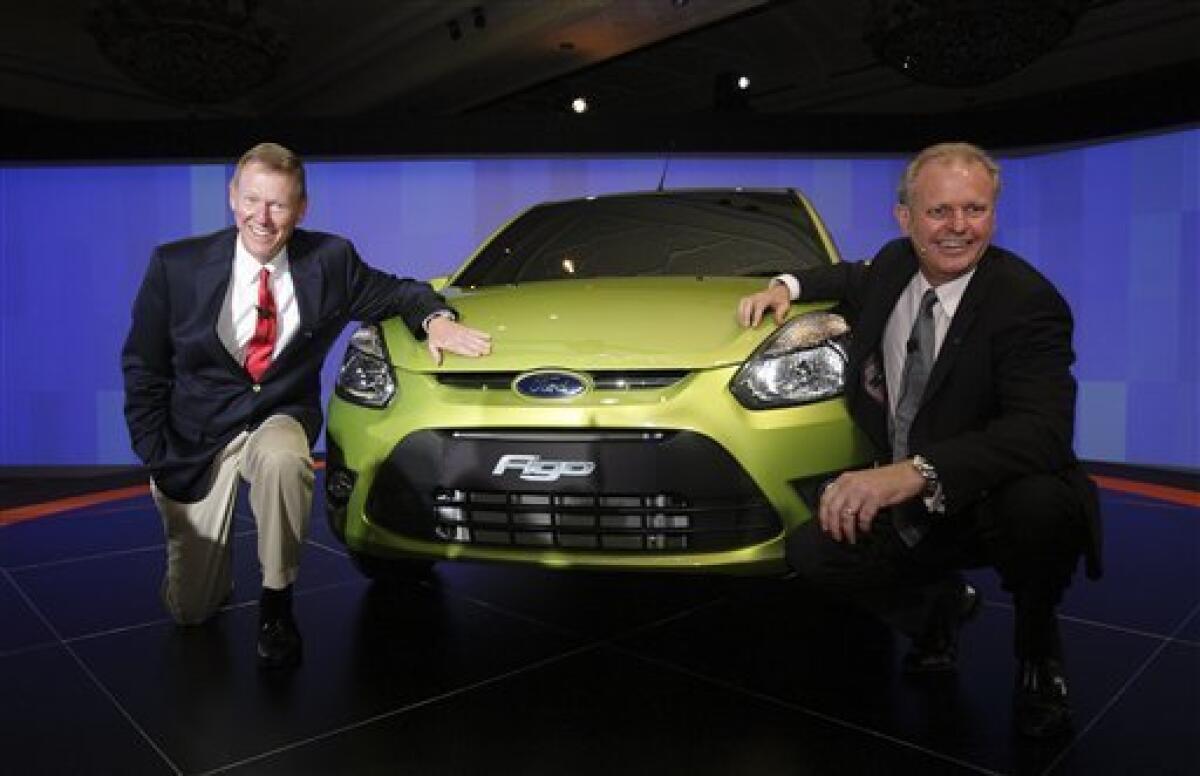Ford to make low cost compact car in India

Ford Motor Co. unveiled a made-in-India compact car and flagged expanded production in China as it seeks to boost sales in Asia, a region the U.S. automaker has hardly dented but is counting on to drive growth.
The four-door “Figo”, which is Italian slang for ‘cool’, will go on sale in India during the first quarter of next year, Ford executives told a press conference Wednesday. There are also plans to export the low-cost car to other Asian countries.
The automaker declined to reveal the Figo’s sale price and initial production volumes. One analyst said he expects the Figo to sell for 300,000 to 400,000 rupees ($6,000 to $8,000), putting it in competition with several other compact models, including the high-end Tata Nano, which sell for 250,000 to 550,000 rupees.
The Figo represents a change of gear for U.S. automakers, which have been slow to penetrate India’s small but fast-growing car market but are now increasingly chasing growth in Asia.
“This new car will be a game changer,” said Michael Boneham, president of Ford India. “It will give us muscle in the heart of the Indian market.”
Ford chief executive Alan Mulally said he expects a third of global car sales to come from Asia in 20 years, a third from the Americas and a third from Europe and Russia.
The company has a lot of catching up to do in Asia. Ford, the only major U.S. automaker to survive the financial crisis without a taxpayer bailout, has about 15 percent market share in North America, 10 percent in Europe and just 2 percent in Asia.
Executives said they would be making an announcement later this week about ramping up Ford’s China production capacity, currently at 450,000 vehicles a year. They wouldn’t confirm reports the automaker will open a third assembly plant in China.
The Figo is the first fruit of a $500 million India investment Ford announced last year. That money will also be used to double production at its factory in the southern city of Chennai, to 200,000 vehicles a year, and raise engine production to 250,000 a year. The expansion is part of Ford’s effort to transform India into a small car production and export hub – a strategy that Hyundai, India’s largest car exporter, has excelled at.
In India, U.S. automakers have proven less nimble than their Japanese, Korean and Indian competitors in offering cars that are small and cheap enough to attract the mass of the buying public.
Three-quarters of all cars sold in India are compacts. Though Ford has been doing business in India since 1995, the Figo is its first compact offering to target the mass market.
“It will position them in a growing market in a segment that’s got volume,” said Dilip Chenoy, director general of the Society of Indian Automobile Manufacturers, an industry group.
India’s auto industry was quick to emerge from the global downturn. Sales began to recover in February and so far this fiscal year, from April through August, car sales have risen 13.5 percent over last year.
Maruti Suzuki, hand-picked by the government in the early 1980s to manufacture cars in India, still dominates the industry. It has sold 334,897 cars so far this fiscal year, 47 percent of the total.
Together, India’s top three car companies by domestic sales – Maruti Suzuki, Hyundai, and Tata Motors – have accounted for 77 percent of car sales this fiscal year.
Ford sold just 10,768 cars in the same period, lagging rival General Motors, which sold 25,050 cars.
Mulally said Ford had to integrate and scale up its global operations before it could generate the sales volumes that would make production of a low-cost compact like the Figo profitable.
“This is our chance where we can bring features and capacities to a small car and offer it at a competitive price and still make money,” he told the Associated Press.
The Indian market has also matured, with a growing number of customers ditching their motorbikes for cars with some of the features and performance U.S. and European consumers take for granted.
In designing the Figo, Ford did extensive market research, nicknaming its archetypal consumer “Sandeep.” Sandeep is 27 years old, recently married, makes 300,000 to 400,000 rupees ($6,000 to $8,000) a year and still lives with either his or his wife’s parents.
Ashwin Patil, an analyst at HDFC Securities in Mumbai, said he expects the Figo to sell for 300,000 to 400,000 rupees ($6,000 to $8,000). It will be in competition with cars like Maruti’s Alto and Swift, Hyundai’s Santro, and the high-end Tata Nano model, which sell for 250,000 to 550,000 rupees.
“In the U.S. the demand wasn’t there ever for the small cars. It was always for the sedans and the premium cars. In India it’s the other way around,” Patil said.
“This step Ford has taken to launch a small car in India is an eye-opener for U.S. auto companies,” he said. “They’ll be able to gain a good chunk of the pie.”